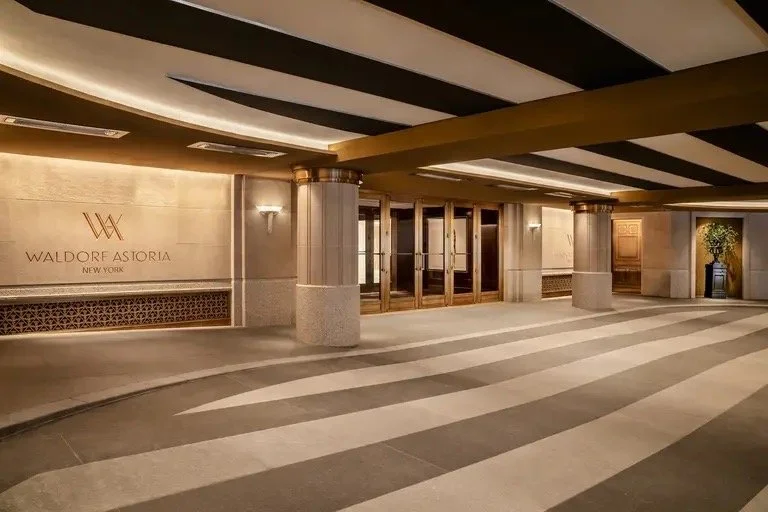New York City’s legendary Waldorf Astoria has finally reopened after a major restoration project that transformed the 1,400-room hotel into 375 luxury condos and 375 hotel rooms. The landmarked Art Deco icon closed in 2017 and was originally scheduled for completion in 2021. Led by the architectural firm Skidmore, Owings & Merrill (SOM), the restoration refreshed many of the hotel’s most iconic fixtures while introducing new elements that reflect the original vision of architects Schultze & Weaver, as the New York Times reported.
Originally built as two separate hotels—the Waldorf and the Astoria—on adjacent lots below 34th Street on Fifth Avenue, the Waldorf-Astoria closed in 1929 to make way for the Empire State Building. Just months later, the hotel’s owners struck a deal to relocate to its current site: a full block between 49th Street and 50th Street, from Park Avenue to Lexington Avenue.
Courtesy of the Waldorf Astoria New York
In 1931, the Waldorf Astoria reopened as a 47-story limestone skyscraper featuring twin decorative copper spires and nearly 2,000 rooms. The hotel quickly gained a reputation as the preferred destination for the world’s most influential figures.
According to the Times, the hotel’s famed Grand Ballroom hosted the April in Paris Ball, where door prizes included a full-length mink coat and a diamond necklace—and socialite Elise Maxwell famously made her entrance atop an elephant.
In 1977, hotelier Conrad Hilton acquired the Waldorf Astoria after years of expressing his desire to own what he reportedly called “the greatest of them all.” In 2014, Hilton sold the property to the Chinese firm Anbang Insurance Group for $1.95 billion—the most expensive hotel sale in history, a record that still stands. As part of the deal, Hilton retained a 100-year contract to continue managing the hotel.
Anbang closed the hotel in 2017 to begin renovations and convert the upper floors into condominiums. However, after the company became involved in a 2018 corruption scandal, the Chinese government seized control of Anbang, and the property was put under the control of Dajia Insurance Group.
On the third floor, the Silver Corridor connects the hotel event spaces. Its murals have been cleaned and restored.
The transformation was led by SOM, with hotel interiors designed by Pierre-Yves Rochon (PYR) and residential interiors and amenities designed by Jean-Louis Deniot.
SOM’s work draws on archival research and collaboration with the Landmarks Preservation Commission, striking a balance between preservation, restoration, and adaptive reuse, according to a press release.
The city designated the building as an exterior and interior landmark, with 62,000 square feet of interior space recognized by the LPC. The project is considered one of the largest preservation and adaptive reuse projects in city history.
The restoration of the interior improved access, expanded space, and introduced new pathways for natural light. Additionally, the hotel’s beloved murals—some dating back to the 18th century—were carefully restored by ArtCare Conservation.
The design creates an intentional “spatial sequence,” moving from smaller, intimate areas to spacious, light-filled rooms, conceived through material and tonal consistency. The new reception area features the same marble used in the historic Peacock Alley columns for its fireplace.
Portoro marble, mosaics, and restored decorative details were preserved and relocated to harmonize with modern elements like integrated lighting, automated curtains, and custom-designed furniture.
PYR chose a palette of neutral, mineral tones to highlight the new spaces and the presence of original materials. Every element was carefully selected to complement the architectural order and enhance the visitor’s experience.
“In many ways, Waldorf Astoria New York is the most important hotel in the world. It is the original luxury property and the place where luxury service was perfected. It not only holds a special place in Hilton’s history, but also in modern history,” Chris Nassetta, president and CEO of Hilton, said.
“Today, we build on this legacy as we mark the start of a new chapter for this iconic property. We look forward to once again welcoming guests to experience its timeless charm and modern enhancements, as this hotel and Waldorf Astoria properties around the world set the standard for luxury stays.”
In Peacock Alley, the Waldorf clock, commissioned by Queen Victoria for the 1893 World’s Columbian Exposition, has been cleaned.
Peacock Alley, named after the fashionable attire of its luxurious guests, largely reflects its original 1931 design. Connecting Park Avenue, Lexington Avenue, and the Library Lounge, the space serves as the hotel’s main thoroughfare. Guests can admire the historic Waldorf Astoria clock, commissioned by Queen Victoria for the 1893 World’s Columbian Exposition, which now gleams after careful restoration.
According to the Times, conservation workers meticulously restored the clock over more than a year by carefully cleaning, stripping, rebuilding, and repairing every inch of its more than 100 components.
Cole Porter’s piano has also been carefully restored and relocated to Peacock Alley. The legendary pianist and composer was a long-time resident of the hotel and received the Steinway piano as a gift from hotel staff.
Guests can now enjoy live performances at the piano. Peacock Alley also features a creative cocktail menu honoring the legacy of NYC’s cocktail culture, along with a selection of light bites.
Courtesy of the Waldorf Astoria New York
Lex Yard, the Waldorf’s signature restaurant, designed by AvroKO’s New York studio, is located at the corner of Lexington Avenue and 50th Street. This two-story, 220-seat American brasserie is helmed by Chef Partner Michael Anthony, which features a menu celebrating seasonal ingredients and world-class technique.
An elegant dining room and bar offer cocktails crafted by mixologist Jeff Bell and welcome guests for breakfast, lunch, and dinner. Additionally, two private dining rooms on each floor accommodate up to eight guests individually or 18 when combined.
The Japanese dining concept Yoshoku offers an intimate experience inspired by the Waldorf’s architectural storytelling. Situated beside Louis Rigal’s 148,000 hand-cut tile “Wheel of Life” mosaic and neoclassical mosaics celebrating the rituals of food and gathering, the restaurant presents a kaiseki-inspired menu reimagined through a New York lens.
Diners can enjoy a six-course tasting menu featuring dishes like grilled lobster, toro tartare with caviar, and king crab with Tosazu jelly. A la carte options are also available. Drink selections include sake, champagne, Japanese spirits, and signature cocktails.
Park Avenue lobby features the “Wheel of Life” marble floor mosaic by artist Louis Rigal. It is made from 148,000 pieces of stone.
Guests now arrive at the hotel through three entrances, including a hotel porte-cochere on 49th Street between Lexington and Park avenues, the only one of its kind in Manhattan. There are also entries on Park Avenue or Lexington Avenue between 49th and 50th Streets.
The 49th Street porte-cochere.
Atop the Park Avenue entrance sits the restored “Spirit of Achievement” statue by Icelandic artist Nina Saemundsson, which has adorned the entryway since the hotel opened in 1931.
The Waldorf now offers some of the largest guest rooms and suites in Manhattan, with most rooms measuring over 570 square feet and ceiling heights averaging eight to nine feet, according to the Times. The smallest rooms are twice the size of those in the original hotel. There are more than 11 distinct room categories, each designed to feel like a private apartment with connected zones for living, working, and sleeping.
The rooms feature soft leathers, polished woods, and tailored upholstery in a palette of light and neutral tones, creating a tranquil retreat from the bustling Manhattan streets. Custom furniture and artisanal hardware enhance the hotel’s sense of luxury and exclusivity, including a bespoke bar in each room.
Spa-like bathrooms showcase marble finishes, walk-in showers, separate toilets, and dressing areas. A direct pathway from the dressing area to the guest room door makes unpacking luggage easy.
Guests can now book stays at the Waldorf Astoria New York and make reservations at Lex Yard, Peacock Alley, and Yoshoku. Room rates start at $1,500 a night.
On September 1, the hotel will celebrate the grand reopening of its 43,000 square feet of meetings and event spaces, including the iconic Grand Ballroom as well as the Basildon, Jade, and Astor Rooms. Guests can also look forward to the debut of the Guerlain Wellness Spa.
In February, the Waldorf welcomed its first condo residents following the restoration. Closings began at the end of December, with residences ranging from studios to four-bedroom units and penthouses, many featuring unique layouts and private spaces.
Current availability at the Waldorf Astoria Residences New York starts at $1.875 million for studios and goes up to $16.875 million for four-bedroom residences.
Waldorf Astoria New York reopens for the first time since 2017
July 22, 2025
All images courtesy of the Waldorf Astoria New York, unless noted otherwise






